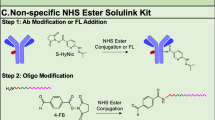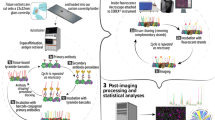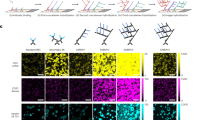Abstract
Semiconductor quantum dots (QDs) are among the most promising emerging fluorescent labels for cellular imaging. However, it is unclear whether QDs, which are nanoparticles rather than small molecules, can specifically and effectively label molecular targets at a subcellular level. Here we have used QDs linked to immunoglobulin G (IgG) and streptavidin to label the breast cancer marker Her2 on the surface of fixed and live cancer cells, to stain actin and microtubule fibers in the cytoplasm, and to detect nuclear antigens inside the nucleus. All labeling signals are specific for the intended targets and are brighter and considerably more photostable than comparable organic dyes. Using QDs with different emission spectra conjugated to IgG and streptavidin, we simultaneously detected two cellular targets with one excitation wavelength. The results indicate that QD-based probes can be very effective in cellular imaging and offer substantial advantages over organic dyes in multiplex target detection.
This is a preview of subscription content, access via your institution
Access options
Subscribe to this journal
Receive 12 print issues and online access
$209.00 per year
only $17.42 per issue
Buy this article
- Purchase on Springer Link
- Instant access to full article PDF
Prices may be subject to local taxes which are calculated during checkout






Similar content being viewed by others
References
Alivisatos, A.P. Semiconductor clusters, nanocrystals, and quantum dots. Science 271, 933–937 (1996).
Bruchez, M. Jr., Moronne, M., Gin, P., Weiss, S. & Alivisatos, A.P. Semiconductor nanocrystals as fluorescent biological labels. Science 281, 2013–2016 (1998).
Chan, W.C.-W. & Nie, S. Quantum dot bioconjugates for ultrasensitive nonisotopic detection. Science 281, 2016–2018 (1998).
Mitchell, G.P., Mirkin, C.A. & Letsinger, R.L. Programmed assembly of DNA functionalized quantum dots. J. Am. Chem. Soc. 121, 8122–8123 (1999).
Mattoussi, H. et al. Self-assembly of CdSe-ZnS quantum dots bioconjugates using an engineered recombinant protein. J. Am. Chem. Soc. 122, 12142–12150 (2000).
Mahtab, R., Harden, H.H. & Murphy, C.J. Temperature- and salt-dependent binding of long DNA to protein-sized quantum dots: thermodynamics of “inorganic protein”–DNA interactions. J. Am. Chem. Soc. 122, 14–17 (2000).
Sun, B. et al. Microminiaturized immunoassays using quantum dots as fluorescent label by laser confocal scanning fluorescence detection. J. Immunological Methods 249, 85–89 (2001).
Pathak, S., Choi, S.-K., Arnheim, N. & Thompson, M.E. Hydroxylated quantum dots as luminescent probes for in situ hybridization. J. Am. Chem. Soc. 123, 4103–4104 (2001).
Han, M., Gao, X., Su, J.Z. & Nie, S. Quantum-dot-tagged microbeads for multiplexed optical coding of biomolecules. Nat. Biotechnol. 19, 631–635 (2001).
Klarreich, E. Biologists join the dots. Nature 413, 450–452 (2001).
Mitchell, P. Turning the spotlight on cellular imaging. Nat. Biotechnol. 19, 1013–1017 (2001).
Niemeyer, C.M. Nanoparticles, proteins, and nucleic acid: biotechnology meets materials science. Angew. Chem. Int. Edn. Engl. 40, 4128–4158 (2001).
Chan, W.C.-W. et al. Luminescent quantum dots for multiplexed biological detection and imaging. Curr. Opin. Biotechnol. 13, 40–46 (2002).
Ross, J.S. & Fletcher, J.A. The Her2/neu oncogene in breast cancer: prognostic factor, predictive factor, and target for therapy. Oncologist 3, 237–252 (1998).
Horton, J. Her2 and Trastuzumab in breast cancer. Cancer Control 8, 103–110 (2001).
Carter, P. et al. Humanization of an anti-p185HER2 antibody for human cancer therapy. Proc. Natl. Acad. Sci. USA 89, 4285–4289 (1992).
De La Cruz, E.M. & Pollard, T.D. Transient kinetic analysis of Rhodamine phalloidin binding to actin filaments. Biochemistry 33, 14387–14392 (1994).
Panchuk-Voloshina, N. et al. Alexa dyes, a series of new fluorescent dyes that yield exceptionally bright, photostable conjugates. J. Histochem. Cytochem. 47, 1179–1188 (1999).
Weiss, S. Fluorescence spectroscopy of single biomolecules. Science 283, 1676–1683 (1999).
Kues, T., Peters, R. & Kubitscheck, U. Visualization and tracking of single protein molecules in the cell nucleus. Biophys. J. 80, 2954–2967 (2001).
Hines, M.A. & Guyot-Sionnest, P. Synthesis and characterization of strongly luminescing ZnS-capped CdSe nanocrystals. J. Phys. Chem. 100, 468–471 (1996).
Dabbousi, B.O. et al. (CdSe)ZnS Core-shell quantum dots: synthesis and characterization of a size series of highly luminescent nanocrystallites. J. Phys. Chem. 101, 9463–9475 (1997).
Acknowledgements
We express our appreciation to Walt Mahoney, Ping Wu, and Charles Z. Hotz for supervising the project and for their critical reading of this manuscript. We thank Don Z. Zehnder, Edward Adams, Ted Haxo, Linh H. Nguyen, Christopher H. Ng, and Susan Palmieri for their contribution in generating QD probes and images. We also wish to acknowledge Hugh Daniels for his participation in the early stages of the work. This work was supported in part by grant R44 CA88391-03 from the National Institutes of Health.
Author information
Authors and Affiliations
Corresponding author
Ethics declarations
Competing interests
The authors declare no competing financial interests.
Rights and permissions
About this article
Cite this article
Wu, X., Liu, H., Liu, J. et al. Immunofluorescent labeling of cancer marker Her2 and other cellular targets with semiconductor quantum dots. Nat Biotechnol 21, 41–46 (2003). https://doi.org/10.1038/nbt764
Received:
Accepted:
Published:
Issue Date:
DOI: https://doi.org/10.1038/nbt764
This article is cited by
-
Ultra-bright near-infrared-IIb emitting Zn-doped Ag2Te quantum dots for noninvasive monitoring of traumatic brain injury
Nano Research (2023)
-
Cancer treatment therapies: traditional to modern approaches to combat cancers
Molecular Biology Reports (2023)



